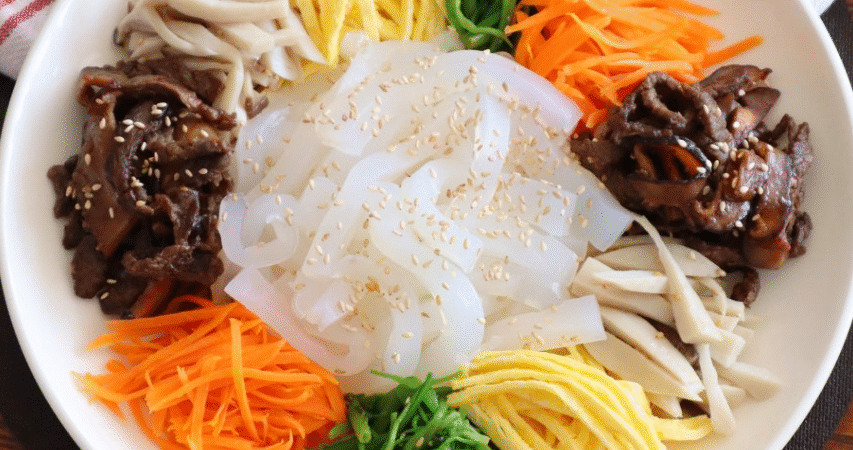Tangpyeongchae Recipe
Tangpyeongchae (탕평채) is a refreshing mung bean jelly salad rooted in royal Korean court cuisine. Featuring the philosophy of Obangsaek (five traditional colors), it blends mung bean jelly, bean sprouts, waterdropwort (minari), shredded beef, egg crepe, and seaweed into a harmonious dish symbolizing balance and wellness.
This dish is especially nutritious, offering low-calorie carbohydrates, lean protein, and fiber-rich vegetables—a perfect choice for those pursuing a healthy, weight-conscious diet.
Ingredients (Makes 4 servings)
- 300 g cheongpomuk (mung bean jelly), sliced thinly
- 100 g beef (lean brisket), julienned
- 1 large egg, beaten into thin crepe and julienned
- 100 g mung bean sprouts, blanched
- 50 g waterdropwort (minari), blanched
- 1 small red chili, julienned (optional color/pop)
- Seaweed (gim/nori), roasted and thinly sliced
Seasoning Sauce
- 2 tbsp soy sauce
- 2 tbsp rice vinegar
- 1 tbsp sugar or light honey
- 1 tsp sesame oil
- 1 tsp toasted sesame seeds
Step-by-Step Cooking Instructions
- Prepare cheongpomuk:
Slice mung bean jelly into 5–7 cm long, 0.5 cm thick strips. If it’s slide-prone, soak in cold water briefly and drain. - Blanch vegetables:
In simmering water, blanch bean sprouts and waterdropwort separately for 1 minute each. Immerse in cold water and drain well . - Cook beef:
Stir-fry julienned beef in a lightly oiled pan over medium heat until just cooked (~2–3 min). Season with a pinch of salt and pepper; set aside. - Make egg crepe:
Whisk egg, cook into a thin layer in non-stick pan, cool, then slice into strips. - Mix sauce:
Whisk soy sauce, vinegar, sugar, sesame oil, and sesame seeds in a small bowl. - Combine ingredients:
In a large bowl, place mung bean jelly, bean sprouts, waterdropwort, beef, egg crepe, chili, and seaweed. - Dress & toss:
Pour seasoning sauce over mixture and gently toss until evenly coated. Serve immediately or chill for an hour for deeper flavor.
Why Tangpyeongchae Is a Great Diet Dish
- Balanced macronutrients: Carbs from jelly, protein from beef and egg, fiber and micronutrients from vegetables.
- Low in calories yet nutrient-dense: Mung bean jelly is composed mostly of water and resistant starch, which helps with satiety and digestive health.
- Rich in vitamins and antioxidants: Sprouts and minari provide vitamins A, C, K, and essential minerals—supporting immunity, bone function, and detoxification.
- Healthy fats: Sesame oil and seeds contain monounsaturated fats and anti-inflammatory lignans, supporting heart health.
- High-fiber, fermented-friendly: Easy to pair with kimchi or gochujang for probiotics and gut health—core ideas in Korean wellness food.
Health Benefits by Ingredient
- Mung bean jelly (Cheongpomuk): Low-calorie and resistant starch supports stable blood sugar and gut-friendly digestion.
- Lean beef: Complete protein with iron, zinc, B-vitamins—ideal for muscle maintenance during dieting.
- Egg crepe: Rich in protein, choline, and nutrients that support metabolism and cognitive function.
- Sprouts & minari: Provide prebiotic fiber and antioxidants—reducing inflammation and promoting microbiome diversity.
- Sesame oil & seeds: Provide unsaturated fats and phytochemicals that support cardiovascular health and anti-inflammatory balance.
- Seaweed: Excellent source of iodine and minerals to help with thyroid regulation and metabolism.
When & How to Serve Tangpyeongchae
The dish is especially refreshing in late spring and summer, offering a light and colorful balance to protein-heavy meals. Serve it as:
- A side dish alongside grilled fish or tofu
- A light main course with brown rice or quinoa
- A party salad centerpiece, impressively colorful and healthful
Diet-Friendly Tips
- Use lean beef cuts or swap in chicken or tofu for a lower-calorie alternative.
- Adjust sugar/vinegar ratio to reduce added sugar.
- Add extra vegetables (cucumber, carrots, spinach) for bulk and volume.
- Store chilled; flavors deepen after a few hours thanks to maceration by the dressing.
Final Thoughts
Tangpyeongchae is more than just a pretty royal salad—it embodies the principles of balanced eating one seeks in diet food: low-calorie, colorful, protein-rich, and full of fiber. It honors the five colors and five flavors of Korean tradition, while supporting digestion, metabolism, and satiety. It’s a dish that nourishes the body, pleases the eye, and delights the palette.
Try this tangpyeongchae at your next meal: it’s an elegant, wellness-forward side that aligns with healthy eating habits and the Korean philosophy of food as medicine
